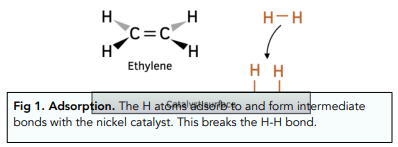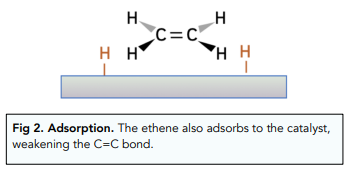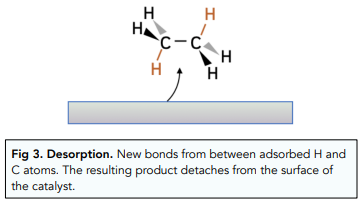Transition Metals - Transition Metals as Heterogeneous Catalysts (A-Level Chemistry)
Transition Metals as Heterogeneous Catalysts
Heterogeneous Catalysts
Heterogeneous Catalysts are crucial in many industrial chemical processes, and understanding how transition metals function within them is a fundamental aspect of chemistry. This knowledge is not only vital for academic study but also for practical applications and problem-solving encountered in Chemical Engineering work experience.
Key Terms
Catalysts increase reaction rates without getting used up. They do this by providing an alternative reaction pathway with a lower activation energy.
A heterogeneous catalyst is a catalyst in a different phase to the reactants.
The catalysts are usually solid with gaseous reactants or in solution. The reaction occurs at the surface of the catalyst.
Contact Process
In the manufacture of sulfuric acid in the Contact Process, vanadium (V) oxide (V₂O₅) catalyses the conversion of sulfur dioxide to sulfur trioxide.
Vanadium (V) oxide has an oxidation state of +5. It is reduced to an oxidation state of +4 in V₂O₄.
V₂O₅ + SO₂ → V₂O₄ + SO₃
V₂O₄ + 0.5 O₂ → V₂O₅
The V₂O₄ is oxidised to back to V₂O₅ with oxygen. The catalyst is re-formed.
Haber Process
In the manufacture of ammonia in the Haber Process, solid iron is used as the catalyst, in a reaction which involves gaseous reactants and products.
N₂ (g) + H₂ (g) ⇌ NH₃ (g)
How a Heterogeneous Catalyst Works
Transition metals as useful as catalysts as they use their 3d and 4s electrons to make bonds with reactant particles.
Here are the steps in how this type of catalyst works:
1. The reactants bind to the active site of the catalyst. At least one of the reactants is adsorbed onto the surface of part of the catalyst, called the active site. This means that the reactants form weak bonds with the catalyst at the active site.

2. There is increased frequency of collisions. This leads to an increase in concentration of reactant particles at the catalyst surface, increasing the frequency of collisions
3. Bonds in the reactants become weaker. Adsorption causes bonds within the reactant molecules to weaken and break.

4. New bonds form between reactants. New bonds form between the reactants particles on catalyst surface.
5. The catalyst releases the product. This weakens the bonds between the catalyst and product. The product leaves the active site, and frees it up for new reactants molecules to adsorb. This is called desorption.

Factors Affecting Effectiveness of Catalysts
The following factors affect how well a metal can be used as heterogeneous catalyst:
1. Strength of Adsorption
If the the adsorption is too strong, the products will not be released from the catalyst surface. This can happen with metals like tungsten.
If the adsorption is too weak the reactants do not adsorb in a high enough concentration to react.
Ni and Pt have the right strength for adsorption, and are most useful as heterogeneous catalysts.
2. Surface Area
A honeycomb support medium is used to vastly increase the surface area of the catalyst and reduce the overall cost.

In a catalytic converter in a car, the catalyst is made from platinum and rhodium. A ceramic honeycomb support medium is used. A thin layer of platinum and rhodium catalyst is coated on the surface, as this is where the reaction occurs. As only a thin layer of catalyst is needed, the cost is greatly reduced.
3. Poisoning
Some catalysts can be poisoned. This occurs because other substances strongly adsorb to the substance, which block the active sites.
This reduces the efficiency of the catalyst and can eventually make it totally ineffective. This reduces the amount of product that can be made over time, which increases the cost of the process.
Poisons are extremely difficult to remove. The whole catalyst needs to be replaced, which is very expensive.
Lead poisons rhodium and platinum catalysts in catalytic converters in cars. Sulfur present as an impurity in the formation of hydrogen gas, poisons iron catalysts in the Haber process, which make ammonia from nitrogen and hydrogen.
Transition metals are elements located in the middle of the periodic table. They have partially filled d-orbitals and exhibit variable oxidation states.
A heterogeneous catalyst is a catalyst that exists in a different phase from the reactants. For example, a solid catalyst can be used to catalyze a reaction in a liquid or gas phase.
Transition metals such as iron, nickel, and copper are commonly used as heterogeneous catalysts in industrial processes. For example, iron is used in the Haber process to produce ammonia, nickel is used in the hydrogenation of vegetable oils, and copper is used in the oxidation of alcohols.
Transition metals act as heterogeneous catalysts by providing a surface for the reactants to adsorb onto. The surface of the catalyst provides active sites where the reactants can undergo chemical reactions. The transition metals can also change oxidation states during the reaction, which helps to facilitate the reaction.
Transition metals are effective and efficient heterogeneous catalysts that can be used to catalyze a wide range of reactions. They are also relatively inexpensive and abundant, making them economically attractive for industrial processes.
The use of transition metals as heterogeneous catalysts is a key aspect of many industrial processes. These catalysts can help to reduce the energy requirements and costs of chemical reactions, making them more sustainable and environmentally friendly. In addition, the use of heterogeneous catalysts can help to increase the yield and selectivity of chemical reactions.





Still got a question? Leave a comment
Leave a comment